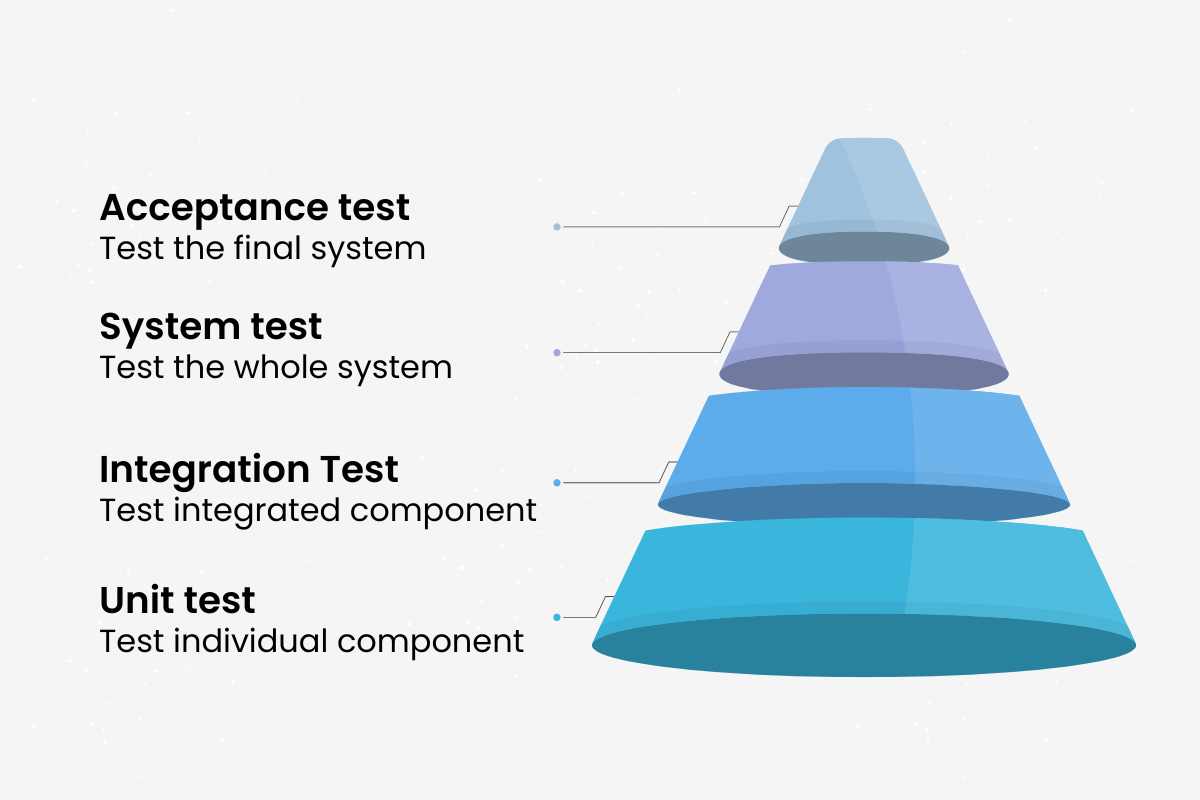As your project expands and the complexity of your codebase grows with more scripts, classes, and methods, it becomes increasingly challenging to ensure that changes made in one part of your code don’t inadvertently cause issues elsewhere.
Unit testing is particularly critical in the realm of software development. It keeps the stability and robustness in check by validating the functionality of individual modules. However, selecting a unit testing approach can pose difficulties due to testing teams’ varying methodologies. Establishing a shared understanding among stakeholders and agreeing on best practices is important before delving into unit testing.
What Is Unit Testing?
Unit testing is a form of software testing that involves examining the smallest functional unit of code. A recommended practice in software development is to break down code into small, functional units, each accompanied by a corresponding unit test. These tests can be written as code and automatically executed whenever changes are made to the software code. This approach enables swift identification of bugs or errors in the code if a test fails. Unit testing promotes modular thinking and enhances both test coverage and quality. Automated unit testing aids in freeing up time for developers to focus on coding by automating the testing process.

When Should Unit Testing Occur?
Unit testing typically serves as the initial phase of testing, conducted before integration testing. While the number of tests conducted in each cycle is extensive, the time required for each test is relatively minimal, given the straightforward nature of code units. Consequently, developers can swiftly carry out unit testing themselves.
Who Conducts Unit Testing?
In teams, developers prefer not to dedicate their limited resources to unit testing, allowing them to concentrate solely on development tasks. In such scenarios, QA engineers assume responsibility for unit testing, incorporating this task into their testing strategy and utilizing existing testing tools to efficiently execute and manage test outcomes.
Why is Unit Testing Important?
Unit testing plays a pivotal role in the software testing process due to the following reasons:
- Early bug detection: Unit testing identifies bugs in the early stages of development, preventing issues from escalating as software components become more intertwined. Without unit testing, a single bug in one piece of code can easily impact multiple parts of the entire system, leading to costly and time-consuming fixes.
- Promotes better code writing: When developers engage in unit testing, they must adhere to coding best practices and ensure that their code is maintainable. This is because unit testing requires each unit to have a clearly defined responsibility that can be tested independently.
- Facilitates debugging: A failing unit test offers valuable insights into the specific unit and location of the problem, streamlining and making the debugging process more efficient.
- Serve as documentation: Unit tests illustrate how individual code units should be utilized and the expected behavior from them. They also serve as comprehensive documentation for the software logic, aiding in knowledge transfer to new team members and preventing regression.
Benefits of Unit Testing
Many professionals in the QA field emphasize the significance of unit testing (UT). Whether you employ extreme programming, Angular UT, or another software development framework, UT should be an integral part of your approach. Here’s why:
Enhanced code refactoring: Unit tests provide a safety net for code refactoring, ensuring that changes can be made without causing disruptions. They mitigate the risks of modifying older source code by identifying potential issues beforehand.
Quality assurance of code: Unit testing serves as a form of quality assurance for code, uncovering problems and bugs before integration testing occurs. Establishing a testing workflow prior to code completion helps address issues early on and encourages developers to write better code.
Early issue detection: Unit testing aids in identifying and addressing problems before they affect other code sections. This includes identifying bugs in the programmer’s implementation and addressing issues with the unit’s specification.
Simplified integration: Unit testing facilitates code refactoring and streamlines the integration process. Identifying changes and assisting in code maintenance and adjustment, unit testing reduces bugs and defects and verifies the accuracy of each unit. This, in turn, simplifies later testing during the integration phase.
System mapping and documentation: Unit testing helps map a system and creates documentation, aiding in understanding the unit’s interface.
Streamlined debugging process: Unit testing simplifies the debugging process, especially with automated quality assurance solutions, leading to efficiency gains.
Encourages better code and design: Whether you’re using C#, Java, Python, JavaScript, or PHP, unit testing encourages the development of well-defined code with high cohesion.
Cost reduction: Utilizing unit tests and effective unit testing tools lowers the overall project cost. Early bug detection minimizes late changes and makes spotting issues easier than addressing them later.
Drawbacks of Unit Testing
Despite its advantages, unit testing also presents some drawbacks that warrant consideration, according to experienced code testers.
Increased code volume: Unit testing necessitates writing additional code. Depending on the system’s complexity, developers typically need to create one or more unit tests, with a recommended minimum of three, to avoid contradictory outcomes. Although the test code should be relatively simple, implementing this testing approach entails more effort and code, translating to increased time and cost.
Challenges with UI testing: Unit tests are not well-suited for testing user interfaces (UI). While they excel in assessing business logic implementation, they are less effective when evaluating UI functionality.
Impact on structural design: Some experts argue that unit tests can negatively impact a product’s structural design by solidifying code structure, making future modifications challenging.
Debate over code quality: While proponents assert that unit testing enhances code quality, detractors argue that it can lead to worsened code and unnecessary indirection. Modifying and expanding code may introduce navigational complexities and delay integration testing.
Limitations in error detection: Unit tests cannot identify all program errors. They are unable to cover every execution path or detect integration errors and systemic issues.
Requirement for realistic testing: Effective unit testing requires the tested unit to behave realistically within the full system context. Failure to achieve this compromises the validity and accuracy of the test results.
Unit Testing Types Breakdown
Functional Testing
Functional testing ensures that individual units of code perform as intended. It involves providing predetermined inputs to the system and validating the resulting outputs. For instance, if there’s a function designed to calculate the square of a given integer, functional testing would involve supplying various numbers as inputs and confirming that the output matches the expected result.
Integration Testing
Integration testing verifies the correct interaction between different units of code. This involves combining code modules and verifying the accuracy of the output. For example, if there’s a function responsible for computing the square of an integer, integration testing would involve testing how this function interacts with other components or modules.
Sanity Testing
Sanity testing is a software testing approach that ensures the system behaves normally under standard conditions. It validates that basic functionality operates as anticipated.
Unit Testing Techniques
Now that you’re familiar with the fundamentals of unit testing, let’s explore some techniques you can employ.
| Mocking | Stubs | Data-driven testing |
|---|---|---|
| Mocking involves creating simulated objects to represent real objects within your code. This allows you to evaluate how your code interacts with other objects without relying on those specific objects. | Stubs are similar to mocks but are primarily utilized for testing external API calls. For instance, suppose you’re conducting a unit test on code that initiates an HTTP request to an external API. To avoid the slowness and potential errors associated with executing actual API calls during testing, you can create a stub that mimics the API call and returns expected data. | Data-driven testing entails structuring your unit tests to facilitate their execution with various datasets. This approach is particularly advantageous when dealing with numerous edge cases or datasets too extensive to be hard-coded into individual unit tests. |
4 Principles of Unit Testing
Isolation of Components
A key principle in unit testing is isolating components. This involves separating the unit being tested from the rest of the code and any external dependencies. The aim is to focus the test solely on the functionality of the unit without interference from other system parts.
Component isolation enables more precise testing and accurate results. It reduces potential error sources, facilitating easier issue identification and resolution. Additionally, it ensures that test failures indicate problems with the unit itself rather than external factors.
This isolation is commonly achieved through mock objects and stubs, which mimic real object behavior. These tools establish a controlled environment for independent unit testing, ensuring that test outcomes reflect solely on the unit’s performance.
Consistent and Repeatable Outcomes
Consistency and reproducibility mean that when you conduct a test repeatedly under the same conditions, it should yield the same results each time. Inconsistent outcomes can lead to confusion and hinder problem diagnosis and resolution.
Reproducible tests are essential for regression testing, ensuring that previously functioning features remain intact after modifications. If a test yields varying results with each run, it becomes challenging to determine whether a failure stems from a new issue, an existing problem, or the test procedure itself.
Equally vital is consistency. If a test passes on one developer’s machine but fails on another, pinpointing the cause can be difficult. Consistent results across diverse environments (such as development, staging, and production) help guarantee that the software behaves predictably, regardless of the execution environment.
Test Small Portions of the Codebase
A core principle of unit testing involves breaking down the intricate software system into bite-sized, testable segments. By honing in on a small portion of the code, we ensure each segment operates correctly in isolation before merging them.
Testing small segments of the codebase streamlines the process, making it more manageable and efficient. Instead of attempting to test the entire application or major components simultaneously, unit testing enables developers to focus on individual pieces, facilitating easier issue identification, localization, and resolution.
Furthermore, scrutinizing small segments of the codebase enhances testing granularity. This approach permits a more meticulous and comprehensive assessment of the software, ultimately elevating its overall quality.
Automation in Testing
Unit testing frequently involves automation, with automated unit tests being scripts authored by developers to automatically execute tests and verify code functionality. These tests are intended to run automatically whenever changes are made to the codebase, promptly alerting developers to any issues that arise.
The use of automation in unit testing offers numerous advantages. It saves time and effort by enabling tests to be conducted regularly without manual intervention. Additionally, automation ensures consistent test execution, minimizing the potential for human error.
Moreover, automated tests serve as a safety net for developers. They can confidently make changes and refactor code, knowing that automated tests will identify regressions. Ultimately, automation in testing results in more robust, dependable, and high-quality software.
Unit Testing Best Practices
To optimize your unit testing process, consider these best practices:
Utilize a unit test framework
Instead of crafting custom unit tests for each block of code, leverage automated testing frameworks tailored to your programming language. Popular examples include pytest and unittest for Python. These frameworks are extensively used across projects of varying scales in software development.
Automate unit testing
Automating unit testing integrates it into various stages of software development. For instance, trigger tests before pushing changes to a branch via version control software or before deploying software updates. Automated unit testing ensures thorough test coverage across different events and scenarios throughout the development lifecycle.
Limit assertions
In each unit test, aim for a single true or false outcome. Ensure that each test contains only one assert statement. Multiple assert statements within a single test block can lead to confusion regarding an issue’s source if one fails.
Prioritize unit testing implementation
Although unit testing is vital for software development, many projects overlook it due to time constraints, especially during the prototype or quick coding phases. However, integrating unit testing as a standard practice from the project’s outset streamlines the process and facilitates its adoption and repetition.
In a nutshell
Unit testing stands as a fundamental practice in software development, essential for every developer’s toolkit. By implementing automated tests for your code, you guarantee its current functionality and future reliability. When other developers utilize your software, they benefit from smoother code execution, knowing you’ve already verified its expected behavior. This preventive measure prevents bugs from slipping into production—an outcome undesirable for both developers and users alike.
Moreover, unit testing is more manageable and time-intensive than commonly perceived. Instead, it is an enriching learning opportunity for programming enthusiasts seeking a deeper understanding of their code.
ContactContact
Stay in touch with Us









